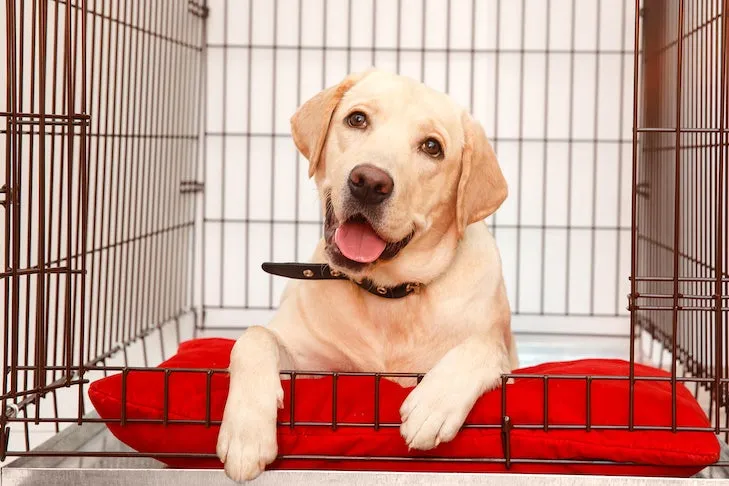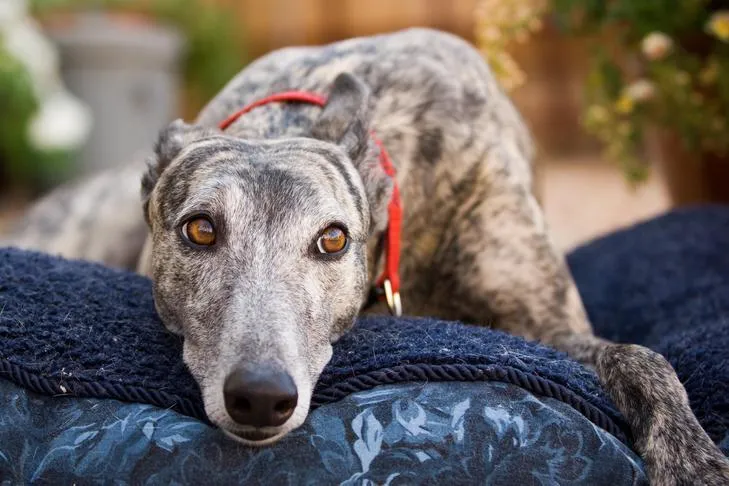Getting your high-energy puppy to settle down in their designated bed or crate on cue can sometimes feel like an impossible feat. However, mastering the “go to bed” command is an incredibly useful skill that provides both you and your puppy with structure and comfort. It’s not just about getting them out from underfoot; it’s about establishing a safe, happy place for them and fostering good behavior.
This guide from Dog Care Story will walk you through the process of Teaching Puppy To Go To Bed, transforming their bed into a cherished spot they happily retreat to when asked. We’ll cover why this behavior is so beneficial and provide clear, step-by-step instructions to help your puppy learn this essential command.
Why a “Go to Bed” Command is Essential for Puppy Owners
The “go to bed” cue offers numerous advantages, making it one of the most important commands to teach puppy. Imagine preparing dinner without your curious puppy constantly underfoot, or enjoying a quiet moment with guests without them pestering for attention. This command provides you with uninterrupted, puppy-free time, granting you peace of mind knowing exactly where your puppy is and that they are settled.
Furthermore, sending your puppy to their bed is a fantastic strategy for managing common puppy problem behaviors like jumping on visitors or begging at the dinner table. Instead of constantly reacting to these annoying habits, you teach an alternative, positive response. For instance, when the doorbell rings, you can confidently ask your puppy to “go to bed.” They can’t bother guests if they’re calmly lying in another room.
While a crate can serve this purpose, choosing a portable dog bed or mat offers added flexibility. You can easily move it between rooms or take it with you when traveling. Once your puppy associates their special bed with comfort and safety, it becomes a reassuring presence in unfamiliar environments, be it a new house or even during a vet visit.
Making Their Bed a Happy Place for Your Puppy
The foundation of successful “go to bed” training lies in ensuring your puppy genuinely loves their bed. If they view it as a place of punishment or isolation, getting them to stay there will be an uphill battle. Instead, you need to convince them that their bed is a fantastic spot through positive reinforcement and high-value treats.
You can significantly boost your puppy’s affection for their bed by making it a source of special rewards. For example, if you’re giving your puppy a new chew bone or a favorite toy, present it to them exclusively on their bed or mat. These bonus items create a strong positive association, teaching your puppy that this particular spot is highly rewarding and worth their time and attention. Essentially, you’re creating their personal happy place.
 Happy Labrador puppy relaxing calmly in an open crate, learning to settle in its designated bed space.
Happy Labrador puppy relaxing calmly in an open crate, learning to settle in its designated bed space.
Step-by-Step Guide to Teaching Your Puppy to Go to Bed
Before you embark on teaching puppy to go to bed, ensure your puppy has a solid grasp of the “lie down” command. They also need a clear release word, such as “free” or “okay,” which signals they are allowed to leave their bed. Your goal is for your puppy to remain in their bed until you give this release cue.
This behavior can be effectively trained using methods like shaping or luring, and it’s an excellent exercise for clicker training if you use one. The following steps will guide you through training your puppy to happily go to their bed:
Step 1: Introduce the Bed and Reward Interaction
Start by placing the bed or mat on the floor. With your puppy nearby, click and reward any positive attention they show towards it, such as sniffing, looking at it, or even just standing next to it. Alternatively, you can gently lure your puppy onto the mat using a treat. As soon as they place at least one paw on it, click and reward. Always place the treat directly on the mat to reinforce the association between the bed and the reward. Continue to click and treat as long as your puppy is engaging with the bed.
Step 2: All Paws On and Introduce Release
Gradually shape your puppy’s behavior until all four paws are on the mat. If you’re luring, ensure you guide your puppy completely onto the bed. Click and reward them generously while they are on the mat. Now, introduce your release word. Say “free” or “okay,” and then gently lure your puppy off the mat, perhaps by tossing a treat or a favorite toy a short distance away. Do not click or reward your puppy for leaving the bed, only for being on it. This helps clarify that the reward is for staying. This is one of the easy dog tricks to teach your puppy that lays a strong foundation.
Step 3: Encourage Voluntary Return
After releasing your puppy, wait quietly to see if they voluntarily return to their bed. If they do, click and treat immediately. If not, repeat Step 2 a few more times, then try again. Once your puppy understands that the bed is where you want them to be, you can move to the next step. Consistency is key here.
 Graceful Greyhound dog comfortably lying on an outdoor dog bed, demonstrating good 'place' behavior.
Graceful Greyhound dog comfortably lying on an outdoor dog bed, demonstrating good 'place' behavior.
Step 4: Add the “Down” Command
Once your puppy is reliably going to their bed, the next step is to ask them to lie down. When your puppy is on the bed, you can lure them into a down position with a treat before clicking and rewarding. Alternatively, use your verbal “down” command or a hand signal if they already know it. If your puppy is experienced with shaping, you can wait for them to offer a down naturally. As always, release your puppy after the reward. This is one of the best tricks to teach a puppy to improve their focus.
Step 5: Increase Duration
Now, it’s time to build duration. Begin by waiting for progressively longer periods before you click and treat your puppy for staying in their bed. Start with just a second or two, then gradually extend the time. Remember the “three Ds” of dog training: duration, distance, and distraction. Focus on only one D at a time to avoid overwhelming your puppy.
Step 6: Increase Distance
Once your puppy is confidently staying in their bed for a reasonable duration, start adding distance. Send your puppy to their bed from farther and farther away. Begin by taking a step back, then two, then eventually move across the room while they are lying calmly on their bed. Gradually increase the distance, always returning to reward them on the bed. For more focus techniques, consider teaching leave it to a dog as well.
Step 7: Introduce Distractions
With duration and distance established, it’s time to introduce distractions. Start with low-level distractions, like a quiet noise or a person walking by at a distance. Gradually increase the intensity of distractions, always ensuring your puppy can succeed. If they break their stay, simply guide them back to their bed and reduce the distraction level.
Step 8: Add Your “Go to Bed” Cue
Finally, once your puppy understands the behavior reliably, regardless of duration, distance, or distractions, you can add your verbal cue. Choose a consistent word like “Bed,” “Crate,” or “Place.” Say the cue, then guide your puppy to their bed. With consistent practice, they will soon associate the cue with the action. Mastering commands like “go to bed” lays the groundwork for more advanced behaviors, even something like teach dog to speak on command.
Most puppies will progress through these steps quickly. However, if your puppy struggles, it often means you’ve moved too fast. Simply go back a step or reduce the difficulty and practice more. Remember to train in various rooms and environments to help your puppy generalize the “go to bed” behavior. Before you know it, you’ll have a practical method for managing your puppy’s space, and your puppy will have a cherished spot to relax.
Conclusion
Teaching puppy to go to bed is a fundamental skill that significantly enhances harmony in your home. By creating a positive association with their bed and following these step-by-step instructions, you equip your puppy with a valuable command that offers them comfort and gives you greater control over their behavior. Consistent, positive reinforcement is the cornerstone of successful training, fostering a stronger bond between you and your furry companion. Start practicing today, and watch your puppy happily embrace their special place.
